Hey, let’s get started on designing a pollinator-friendly garden to attract bees and butterflies. First, focus on picking native plants that thrive in your area, like black-eyed Susans or milkweed. Check your local nursery for options suited to your USDA hardiness zone. Want to know the best layout for maximum buzz? Stick around for tips on spacing and bloom times to keep those pollinators coming back!
Contents
Native Plant Selection
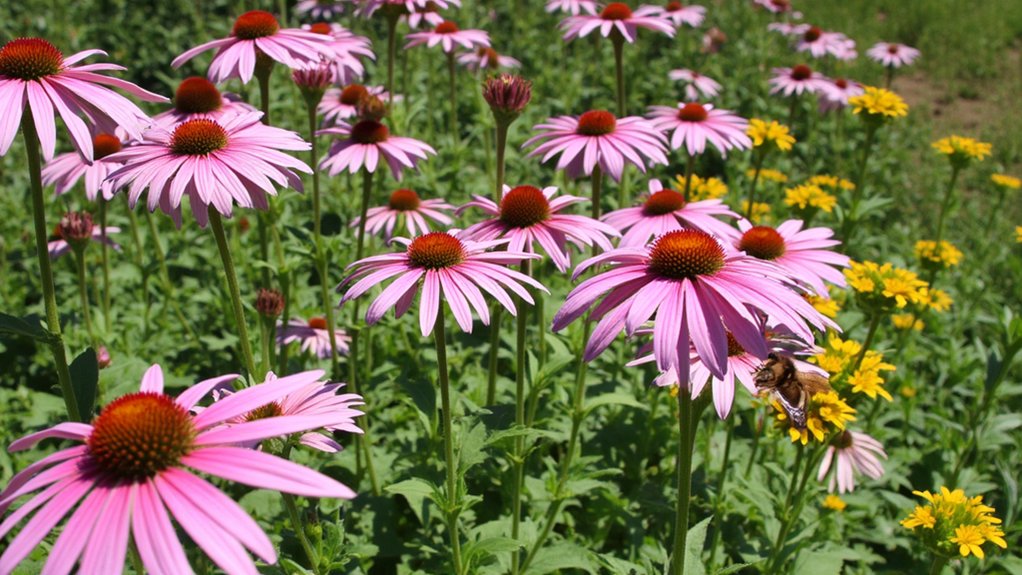
While you’re planning your pollinator-friendly garden, let’s dive right into selecting native plants. You’ve gotta pick species that naturally grow in your region, as they’re best suited to your climate and soil. This choice helps pollinators like bees thrive with familiar food sources.
Start by researching plants native to your area, using local extension services or native plant societies. Focus on varieties that bloom at different times, ensuring a steady nectar supply from spring to fall. For example, plant goldenrod for late summer, about 2-3 feet tall, spacing them 18 inches apart for growth.
Check your hardiness zone, too, on the USDA map online. Match plants to your zone for success. Stick with natives, and you’re setting up a solid foundation!
Colorful Flower Choices
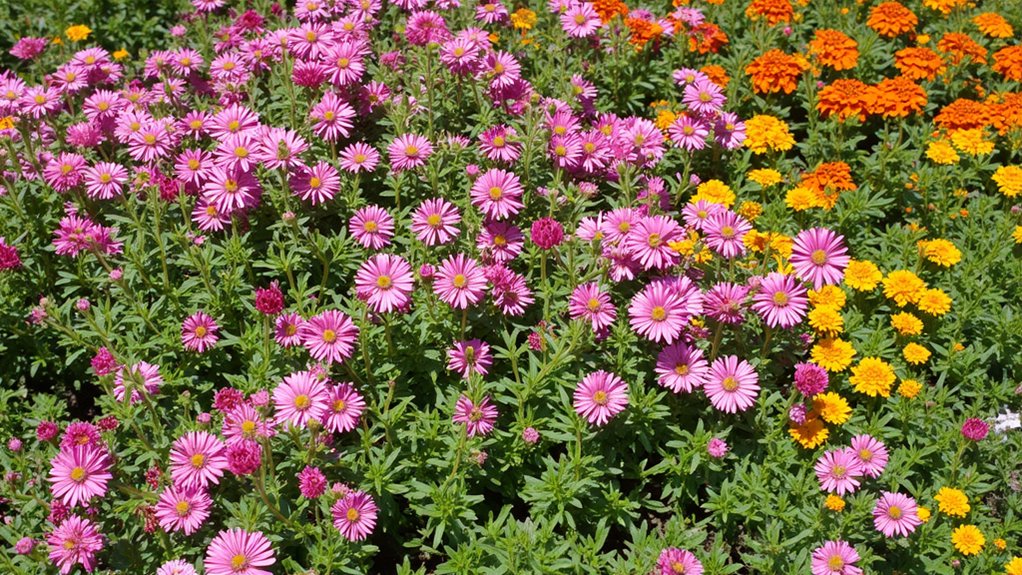
As you build on your native plant foundation, let’s explore colorful flower choices for your pollinator-friendly garden. Bees and butterflies can’t resist bright hues, so pick vibrant blooms to draw them in. Think bold reds, sunny yellows, and deep purples—colors that pop in sunlight.
Start with flowers like zinnias, which grow 1-3 feet tall and offer a rainbow of shades. Plant them in clusters, spacing seeds about 6 inches apart, to create eye-catching patches. Next, try coneflowers; their pink and purple petals are a magnet for pollinators. Make sure you place them in full sun, as they need 6-8 hours daily.
Don’t skimp on variety, though. Mix in marigolds for gold tones, ensuring your garden’s a buzzing, fluttering hotspot.
Seasonal Bloom Planning
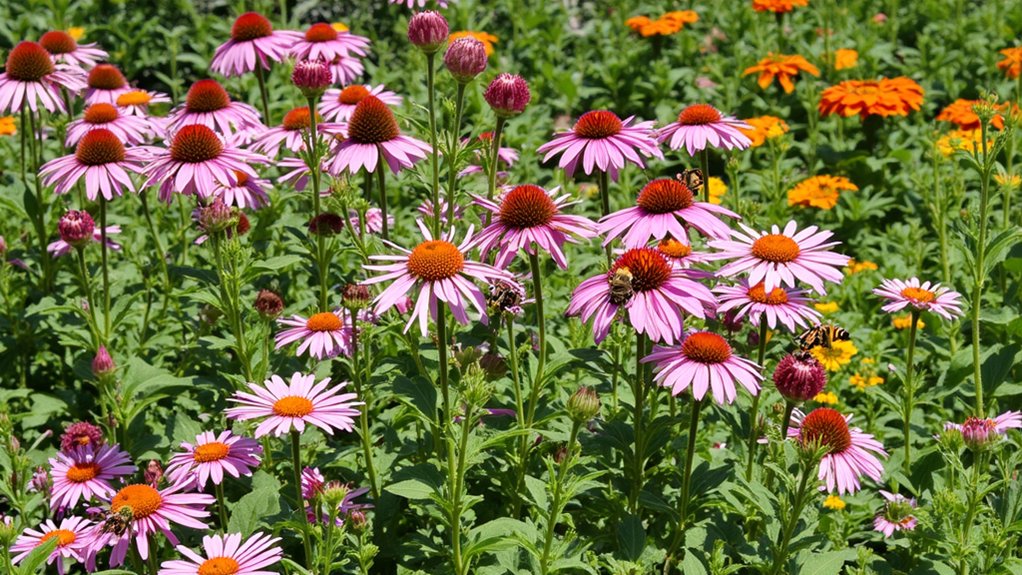
Let’s shift gears from picking vibrant flowers to planning when those blooms will shine in your pollinator-friendly garden. Timing’s everything, so you’ve gotta guarantee bees and butterflies have food year-round. Aim for a mix of plants blooming in spring, summer, and fall.
Start by mapping out your garden’s bloom calendar on paper. List early bloomers like crocuses, popping up in March, then mid-season stars like coneflowers in June and July, and late bloomers like asters, lasting into October. Check plant tags or seed packets for exact bloom times.
Next, plant in clusters, spacing groups 12-18 inches apart for visibility. You’ll keep pollinators fed across seasons with this plan, so get planting and watch your garden thrive!
Water Source Provision
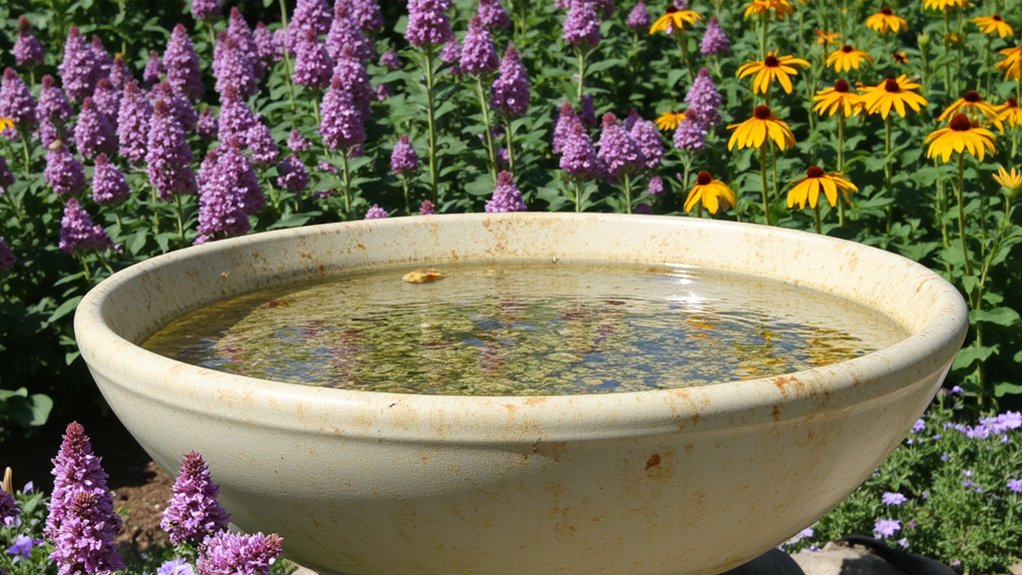
Hey there, setting up a water source is a game-changer for your pollinator-friendly garden. Bees and butterflies need hydration, just like us, so let’s make it easy for them.
Start with a shallow container, like a birdbath or pie tin, no deeper than 1-2 inches. Fill it with clean water, and add small rocks or pebbles so they’ve got safe landing spots to sip from. Place it near your blooms, ideally in a sunny spot, and check it daily. Refill as needed, usually every 2-3 days, to keep it fresh.
Don’t let it stagnate; rinse it weekly to avoid gunk. With this simple setup, you’re giving pollinators an essential resource they’ll keep coming back for.
Pesticide-Free Gardening
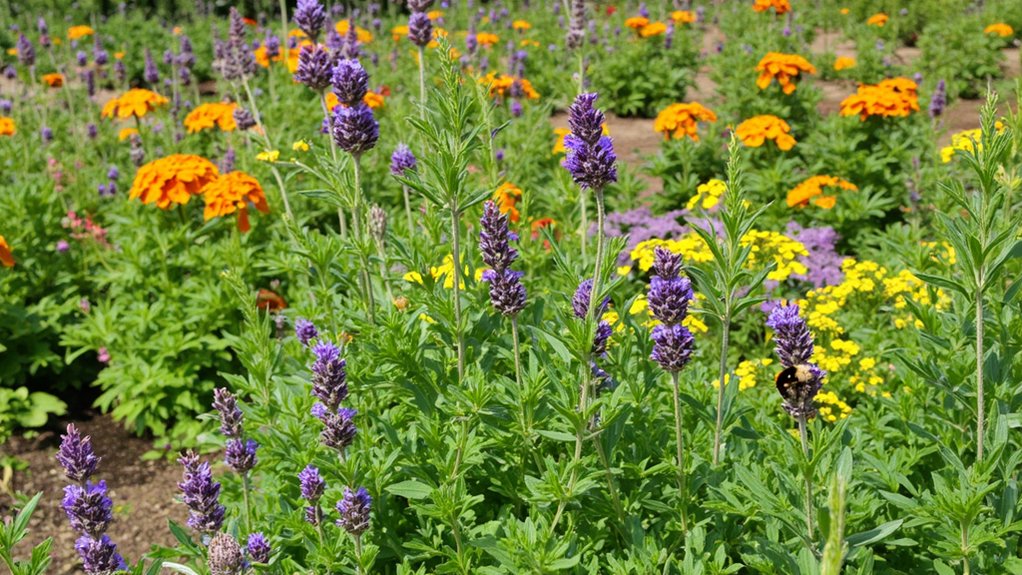
Three key reasons push you toward pesticide-free gardening in your pollinator haven. First, pesticides can harm bees and butterflies, disrupting their delicate systems. Even small doses, like 1 part per billion, can affect their navigation. Second, chemicals mess with the ecosystem, killing beneficial insects alongside pests. Third, you’re ensuring safer food if you grow edibles nearby.
Shelter for Pollinators
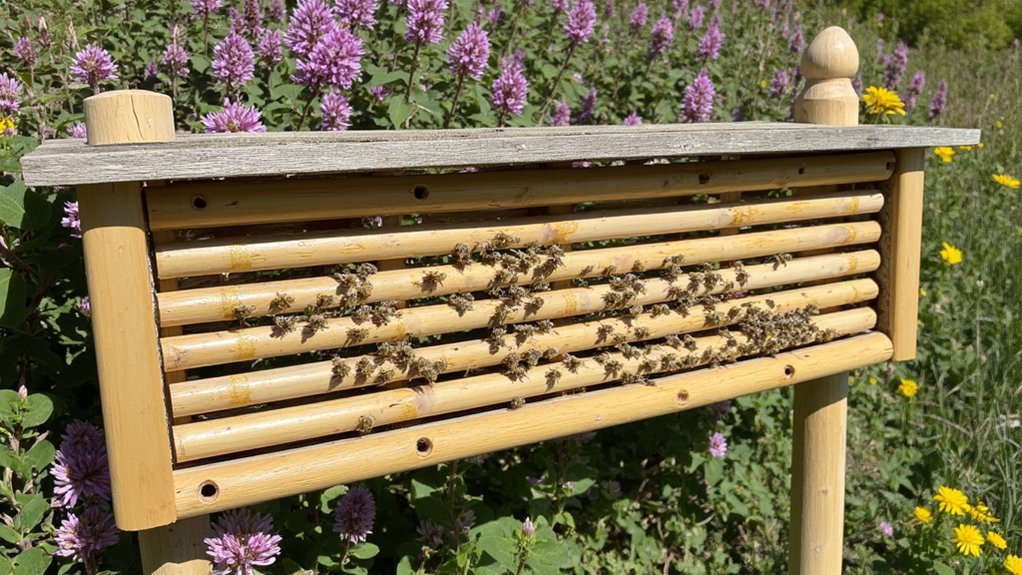
While you’re crafting a pollinator-friendly garden, don’t overlook the importance of shelter for these essential creatures. Bees, butterflies, and other pollinators need safe spots to rest, nest, and weather harsh conditions.
Start by adding natural hideouts, like small brush piles or hollow logs, in a quiet corner. These provide instant cover, especially if you stack them loosely, about 2-3 feet high, for easy access.
Next, consider installing bee hotels—simple wooden boxes with drilled holes, roughly 5-8 mm wide, for solitary bees. Mount them 3-5 feet off the ground, facing south, to catch morning sun.
Finally, leave some bare soil patches, around 1 square foot, for ground-nesting bees. Keep these areas dry and undisturbed, and you’ll see pollinators thrive.
Diverse Plant Heights

Let’s shift gears from building shelters to focusing on the layout of your pollinator-friendly garden with diverse plant heights. You’ve gotta mix things up, creating a visual feast for bees and butterflies. Different heights attract various pollinators, so plan for a range.
Start with low-growing plants, like thyme or clover, around 6-12 inches tall, near the edges. Then, add medium-height flowers, such as coneflowers or salvia, reaching 2-3 feet, in the middle. Finally, plant tall species, think sunflowers or hollyhocks, soaring 4-6 feet, at the back for a tiered effect. This setup, when spaced 12-18 inches apart, gives pollinators easy access.
Don’t just plant randomly; layer intentionally. Watch your garden buzz with life!
Sunny Spot Placement
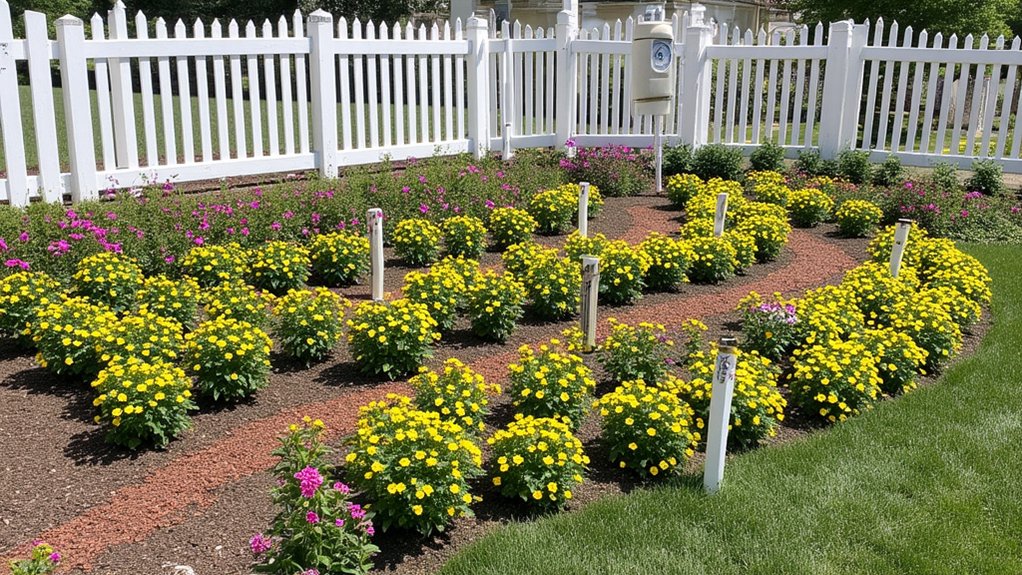
As you plan your pollinator-friendly garden, consider the importance of sunny spot placement for maximum impact. Bees and butterflies thrive in warmth, so you’ve gotta pick the right areas. Aim for spots that get at least 6 hours of direct sunlight daily, ideally facing south or southwest for consistent heat.
Now, check your yard for shady patches from trees or buildings, and avoid planting there. Instead, map out open spaces, maybe near a fence or lawn edge, where the sun hits hard. If you’re unsure, watch the light patterns for a day or two. Place your key pollinator plants, like nectar-rich flowers, in these sunny zones, ensuring they’re spaced 12-18 inches apart for airflow and growth. You’ll see the buzz soon!
Butterfly Host Plants

Ready to boost your garden’s appeal for butterflies? You’ve gotta include host plants, the key spots where butterflies lay eggs. These plants aren’t just pretty; they’re essential for caterpillar survival.
Start with milkweed, a must-have for monarch butterflies. Plant it in clusters, about 18-24 inches apart, in a sunny area. It’s tough, grows 2-4 feet tall, and caterpillars devour it fast. Check local varieties, as some bloom from June to August.
Next, try parsley or dill for black swallowtails. Sow seeds in early spring, spacing them 12 inches apart, and keep them watered. Caterpillars munch on the leaves, so plant extra! Watch for eggs within a week or two.
Pick native host plants when possible; they’re best suited for local butterfly species. Keep experimenting!
Soil Health Improvement
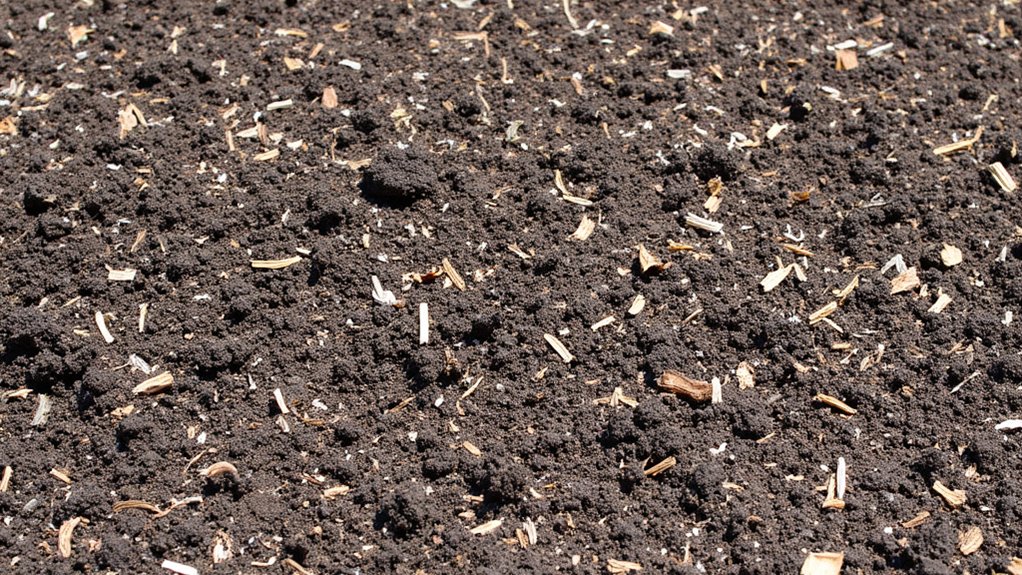
Three key steps can kickstart your journey to better soil health for a thriving pollinator garden. First, test your soil’s pH and nutrient levels. Grab a testing kit from a garden center, follow the instructions, and aim for a pH between 6.0 and 7.0, ideal for most pollinator plants.
Next, add organic matter like compost or well-rotted manure. Spread a 2-3 inch layer over your garden bed, then mix it into the top 6 inches of soil. This boosts nutrients and improves drainage.
Lastly, mulch with straw or wood chips, about 2 inches thick, to retain moisture and suppress weeds. Check soil conditions every spring, and adjust as needed. You’ve got this—healthy soil means happy bees and butterflies!
